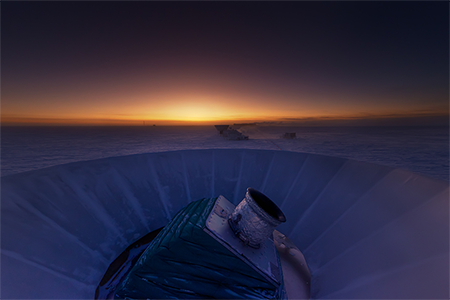BICEP2 Images the Past, Cosmology Looks to the Future
Until a few months ago, a picture of a newly born Universe only existed in our imaginations. But on March 17th, 2014, researchers running the BICEP2 experiment at the South Pole announced that the ripples of an event occurring a mere 10-36 seconds after the big bang may have been detected in their telescope. The measured signal potentially provided the first convincing evidence in support of cosmic inflation, the theory that predicts the early Universe underwent a period of rapid, exponential expansion.
Cosmologists were elated, if cautious. Everyone acknowledged that BICEP2’s extraordinary result had to be confirmed by independent experiments. And many pointed out that the detected signal—a polarization in the cosmic microwave background—could be a more mundane artifact in disguise, resulting, for instance, from dust in our galaxy.
Independently obtained data are on the way, and BICEP2’s interpretation will be subject to more scrutiny, but today, Physical Review Letters announces that the team’s experimental findings have passed the hurdle of peer review and can now be published. This special issue of Physics explores two aspects of the BICEP2 result. In a Viewpoint commentary, theoretical physicist Lawrence Krauss explains the experimental finding, describing how a rapidly expanding Universe would have left its imprint on the cosmic microwave background radiation captured by BICEP2’s telescope. A companion Focus story from physicist and author David Lindley looks at the theoretical ramifications of the result, which are primarily expected to impact cosmology, but could also have implications for particle physics and our understanding of dark matter.
Most important discoveries do not come ready-made for textbooks, and extensive work is still needed to verify the origin of BICEP2’s measured polarization signal. But BICEP2’s result sets the stage for experiments yet to come and an exciting time in cosmology.
– The Editors





